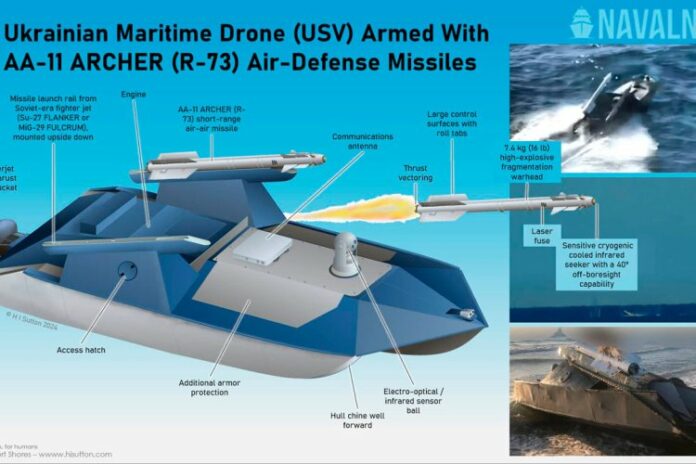Ukraine’s uncrewed surface vessels (USVs) are dominating naval combat in the Black Sea. Yet they have, until now, been particularly vulnerable to aircraft. So Russian defenses have emphasized using helicopters and fighter jets to stop them. Now a version armed with two repurposed air-air missiles could change the tide again.
The war in Ukraine has removed any remaining doubts that drones are transforming warfare. In the naval arena, Ukraine’s maritime drones are leading the world in terms of combat application. These explosive-laden craft first challenged, and then changed, many preconceptions. Now Ukraine has deployed an entirely new category of maritime drone, one armed with air defense missiles.
Until now Ukraine’s maritime drones (USVs) have been most vulnerable to aircraft. They are essentially defenseless against a helicopter armed with a machinegun. Now, with some USVs armed with potent air-defense missiles, Russian pilots may think twice about approaching them.
In practice this is the first such air-defense USV in the world. Other country’s manufacturers have explored giving USVs some form of air defense. But this system is the first fielded operationally, and indeed, the first in combat.
The drone is armed with two missiles
The new USV (uncrewed surface vessel) is distinct from previously observed types, featuring a new wider hull. This allows two missiles to be carried side-by-side.
It is armed with two R-73 air-air missiles. This parallels a trend on land with Ukraine increasingly leveraging missiles designed for one system on another. At least one vintage Osa air-defense system has also been equipped with R-73s, and British supplied ASRAAMs have also been used as ground-based systems. These mix-match systems are informally termed ‘FrankenSAMs’ after Frankenstein’s monster. All the same these missiles now allow the vessel to pose a real threat to aircraft.
The R-73 missile, known by the NATO reporting name AA-11 Archer, is a Soviet-era short-range air-air missile. Carried by fighters like the MiG-29 Fulcrum and Su-27 Flanker, the missile was arguably the best dogfighting missile in service. It was highly agile and had an impressive seeker with 40 degrees off-boresight capability. This meant that it could be launched against a target with was not directly in front of the plane. And to air targeting, the seeker was slaved to a helmet mounted sight.
In the 1980s this was more advanced than the equivalent NATO. Today the latest versions of the Sidewinder, or the ASRAAM, IRIS-T, are arguably more potent. But the R-73 remains a potent system.
The trade-off for surface launch will be range. Even if the vessel can detect the aircraft at range, the missile itself will have around half the range compared to if it was air launched. For the R-73 this means a range of around 15 km (9 miles). In practice, the detection range of the vessels’ electro-optical devices is likely to be the main limitation.
Potential Roles and Impact
The missiles provide the drone with a degree of self-protection. The craft is now better defend itself against Russian helicopters and fast jets. One or two of the FrankenSAM USVs mixed in with a larger force of regular USVs may be enough to inhibit Russian attempts to interdict them.
The system also opens the possibility of using them to ambush Russian aircraft as they take-off or land on Crimean air bases. The USVs can sit off the Crimean coast and pick off the aircraft as they approach unawares. There is at least circumstantial evidence to suggest that this may have already been done.
Many USVs manufacturers around the world are already emulating Ukrainian advances. And there have been several proposals for air defense equipped types even before the Russo-Ukraine War. But the emergence of this type, and its apparent utility, is likely to make those proposals be taken more seriously.
Source: Naval News



